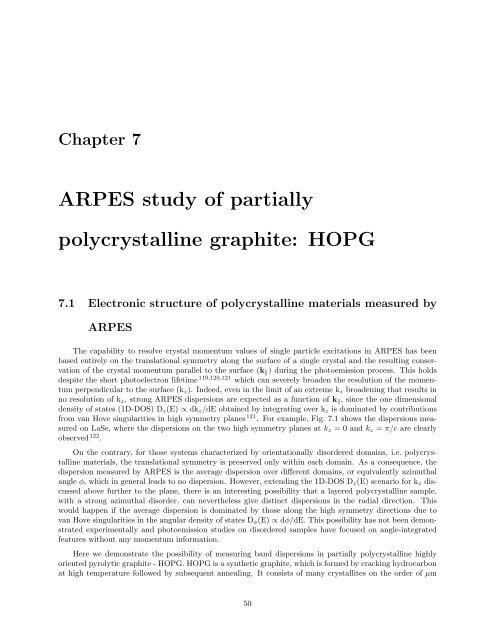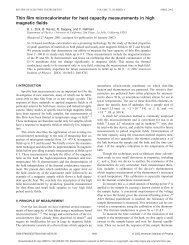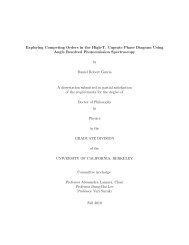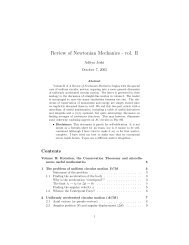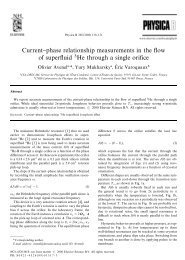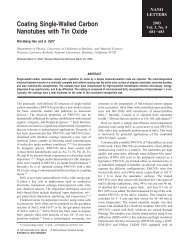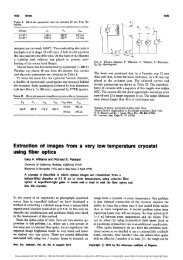Dirac Fermions in Graphene and Graphiteâa view from angle ...
Dirac Fermions in Graphene and Graphiteâa view from angle ...
Dirac Fermions in Graphene and Graphiteâa view from angle ...
You also want an ePaper? Increase the reach of your titles
YUMPU automatically turns print PDFs into web optimized ePapers that Google loves.
Chapter 7<br />
ARPES study of partially<br />
polycrystall<strong>in</strong>e graphite: HOPG<br />
7.1 Electronic structure of polycrystall<strong>in</strong>e materials measured by<br />
ARPES<br />
The capability to resolve crystal momentum values of s<strong>in</strong>gle particle excitations <strong>in</strong> ARPES has been<br />
based entirely on the translational symmetry along the surface of a s<strong>in</strong>gle crystal <strong>and</strong> the result<strong>in</strong>g conservation<br />
of the crystal momentum parallel to the surface (k ‖ ) dur<strong>in</strong>g the photoemission process. This holds<br />
despite the short photoelectron lifetime 119,120,121 which can severely broaden the resolution of the momentum<br />
perpendicular to the surface (k z ). Indeed, even <strong>in</strong> the limit of an extreme k z broaden<strong>in</strong>g that results <strong>in</strong><br />
no resolution of k z , strong ARPES dispersions are expected as a function of k ‖ , s<strong>in</strong>ce the one dimensional<br />
density of states (1D-DOS) D z (E) ∝ dk z /dE obta<strong>in</strong>ed by <strong>in</strong>tegrat<strong>in</strong>g over k z is dom<strong>in</strong>ated by contributions<br />
<strong>from</strong> van Hove s<strong>in</strong>gularities <strong>in</strong> high symmetry planes 121 . For example, Fig. 7.1 shows the dispersions measured<br />
on LaSe, where the dispersions on the two high symmetry planes at k z = 0 <strong>and</strong> k z = π/c are clearly<br />
observed 122 .<br />
On the contrary, for those systems characterized by orientationally disordered doma<strong>in</strong>s, i.e. polycrystall<strong>in</strong>e<br />
materials, the translational symmetry is preserved only with<strong>in</strong> each doma<strong>in</strong>. As a consequence, the<br />
dispersion measured by ARPES is the average dispersion over different doma<strong>in</strong>s, or equivalently azimuthal<br />
<strong>angle</strong> φ, which <strong>in</strong> general leads to no dispersion. However, extend<strong>in</strong>g the 1D-DOS D z (E) scenario for k z discussed<br />
above further to the plane, there is an <strong>in</strong>terest<strong>in</strong>g possibility that a layered polycrystall<strong>in</strong>e sample,<br />
with a strong azimuthal disorder, can nevertheless give dist<strong>in</strong>ct dispersions <strong>in</strong> the radial direction. This<br />
would happen if the average dispersion is dom<strong>in</strong>ated by those along the high symmetry directions due to<br />
van Hove s<strong>in</strong>gularities <strong>in</strong> the angular density of states D φ (E) ∝ dφ/dE. This possibility has not been demonstrated<br />
experimentally <strong>and</strong> photoemission studies on disordered samples have focused on <strong>angle</strong>-<strong>in</strong>tegrated<br />
features without any momentum <strong>in</strong>formation.<br />
Here we demonstrate the possibility of measur<strong>in</strong>g b<strong>and</strong> dispersions <strong>in</strong> partially polycrystall<strong>in</strong>e highly<br />
oriented pyrolytic graphite - HOPG. HOPG is a synthetic graphite, which is formed by crack<strong>in</strong>g hydrocarbon<br />
at high temperature followed by subsequent anneal<strong>in</strong>g. It consists of many crystallites on the order of µm<br />
50


